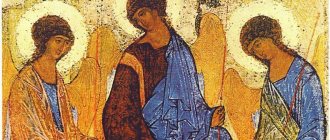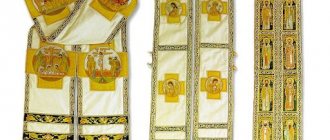This term has other meanings, see Censer (meanings).
It should not be confused with a chandelier - a lamp.
It should not be confused with kandil - a candlestick.
Censer
(Hebrew: מַחְתָּה, מִקְטֶרֶת; Ancient Greek: πυρεῖον, θυμιατήριον, λιβανωτὸν), or
censer
[1] - originally in Judaism, and then in Orthodox and Catholic Christianity, a vessel for burning incense (incense) during certain times types of services in a temple or church.
History[ | ]
The burning of sacrifices before God appeared on Earth in ancient times - the sacrifice of righteous Abel. The Lord Himself in the Old Testament commanded Moses to make a special altar in the tabernacle for sacred incense of aromatic substances (Ex. 30:1-9). The Evangelist John the Theologian described in Revelation the vision he had in the Heavenly Temple of an Angel receiving a golden censer (Rev. 8:3). Censing means the power that drives away evil spirits (Tob. 8:2-3), the glory of God (2 Chron. 5:14), and the smoke rising from the censer
, - offering prayers to God (Ps. 141:2).
History of origin
The division was established in the Old Testament by God himself. The Lord commanded Moses to make an altar for incense and gave clear instructions for its construction:
Holy of Holies in the Temple of King Solomon, 1995. Artist Zeliy Smekhov
And thou shalt make an altar for offering incense, of shittim wood thou shalt make it: the length thereof shall be a cubit, and the breadth thereof shall be a cubit; it must be quadrangular; and the height of it is two cubits; its horns [should come out of it]; overlay it with pure gold, the top thereof, the sides thereof, and the horns thereof; and make a golden crown around it; under his crown, at his two corners, make two rings of gold; make them on both sides of it; and they will be sheaths for poles to carry him on; Make the poles of shittim wood and overlay them with gold. And you shall place him before the veil that is before the ark of the testimony, against the mercy seat that is on the [ark] of the testimony, where I will reveal myself to you.
On it Aaron will burn sweet incense; every morning, when he prepares the lamps, he will smoke with them; and when Aaron lights the lamps in the evening, he will incense with them: [this] is an everlasting incense before the Lord throughout your generations. You shall not offer on it any other incense, nor burnt offering, nor grain offering, nor pour out any drink offering on it (Exod. 30:1–9).
Stationary censer, Byzantium-Syria, 6th century. Photo: https://ruvera.ru
The incense altar is a prototype of the modern censer. Initially, all censers were stationary and consisted of a large bowl on legs, into which burning coal was placed, onto which incense was poured with a special scoop.
In parallel with stationary censers, manual ones began to appear. In shape, they resembled a frying pan or a cylinder with holes on a long handle, into which everything needed for incense was poured.
In Christianity[ | ]
In Christianity, the censer became one of the church utensils and is used in most liturgical rites. Cension has been performed during prayer since apostolic times. Evagrius of Pontus mentions the censer[2]. The censer is stored and prepared for use in a censer niche, where burning coal is placed in it, on which incense is placed - the fragrant resin of Middle Eastern trees. When heated and burned, it emits fragrant smoke - incense[3]. There is a church censer with chains that are attached to the handle, and a cell censer (home censer), with a handle rigidly attached to the side (katseya).
The oldest example of a censer on chains dates back to 1405. Since the 15th century, the censer takes on the shape of a temple and is interpreted as a prototype of the heavenly Jerusalem[4].
In iconography, the censer is an attribute of the holy deacons Lawrence and Stephen. The first biblical high priest, Aaron, was also depicted with a censer. In secular semiotics, the censer acts as an allegory of Asia[5].
In accordance with Orthodox tradition, a deceased deacon is buried with a censer in his hands.
Chopping[ | ]
Before the censing begins, the priest says a prayer:
| We offer the censer to You, Christ our God, into the stench of the spiritual fragrance, even as we are received into Your heavenly mental altar, bestow upon us the grace of Your Most Holy Spirit. |
The liturgical censing is complete
, when a deacon, presbyter or bishop with a censer goes around the entire church, and
a small one
, when they cense the altar, the iconostasis and the people coming from the pulpit. When incense is performed in front of sacred objects - icons, a temple, it relates to God, giving Him due honor and praise. When incense is addressed to people, this testifies that the Holy Spirit descends on all the faithful, as those who bear the image of God. According to Orthodox tradition, it is customary to bow in response to censing. Burning censers are solemnly presented by deacons during the small and great liturgical entrances, and are also used on the vestments of the bishop and during the performance of many rites.
Modern look
Photo by Ilya Svinkovsky
Christians began to use censer during worship starting in the 6th century. They were similar in shape to modern ones: it was a small bowl or sphere on three chains that were connected together. Initially there was no lid - all the elements were of practical importance.
Censer, Byzantium, 6th century. Photo: https://ruvera.ru
Censers with chains came to Rus' from Byzantium in the 11th century. In the 15th century, they took on the form of a temple: a lid in the form of a church dome with holes for air and incense, which ended with a cross, was added to the coal bowl.
Censer, Moscow, late 15th century. Photo: https://ruvera.ru
A 4th chain was attached to it, with which you can lift the lid up and gain access to the coal bowl. The modern censer in the Orthodox Church looks exactly like this.
Additional information[ | ]
The world's largest censer Botafumeiro
attached with ropes to the ceiling of the Compostela Cathedral in Galicia (autonomous region of Spain).
It weighs 80 kg and is powered by swinging by eight servants (Spanish tiraboleiros
) in purple. To fill this censer, which moves at a speed of 60 km per hour, 40 kg of coal and incense are required.
In the story by I. S. Turgenev, King Lear of the Steppes
the writer mistakenly called the censer a chandelier lamp:
“The barely alive sexton came out of the kitchen, with difficulty fanning the incense in the old copper chandelier
. A. A. Fet pointed out this error in 1870 in his letter to his friend I. P. Borisov [10].
The phrase inflate the censer
(derived from
blow up the case
) in a figurative sense means to widely expand any activity [11], as well as to make noise, to overly emotionally express one’s indignation at any reason [12].
Incense
Incense is an aromatic tree resin and incense. When burned in a censer, it symbolically expresses man's reverence for God.
After the birth of Jesus Christ, the wise men brought Him gifts of gold, incense and myrrh. These gifts are prophetic and symbolic - in particular, incense was presented to the Savior as the High Priest and God.
Incense
Real incense is the resin of a rare tree, which we call Lebanese cedar. To get as much of it as possible, small cuts are made on the tree trunk from which it flows. The hardened resin is collected, crushed and mixed with water and aromatic oils.
The resulting paste is rolled out and cut into small pieces, which are sprinkled with white powder - magnesia. This is necessary so that the incense, when stored in the package, does not stick together into one lump and you can take the right amount. Nowadays incense is made from different types of oriental trees.
Notes[ | ]
- Bagdasaryan, Orlova, Telitsyn, 2005.
- Evagrius of Pontus, Abba of Thoughts
- Mikhail Skaballanovich. Censer // Explanatory typicon. - M.: Pilgrim, 1995.
- Apollo. Fine and decorative arts. Architecture: Terminological dictionary. - M., 1997.
- Hall J.
Dictionary of plots and symbols in art. - M., 1999. - ↑ 1 2 Igoshev V.V.
Katsey // Orthodox Encyclopedia. - M.: Tserkovno-nauchny, 2013. - T. XXXII: “Catechism - Kiev-Pechersk Icon “Assumption of the Blessed Virgin Mary”. - pp. 141-144. — 752 p. — 33,000 copies. — ISBN 978-5-89572-035-6. - Igoshev V.V., Makarov E.E., 2012.
- Hieromonk Job (Gumerov)
Can a layman perform incense at home? // Orthodoxy.Ru, 03/18/2008 - Incense: Cistus // Explanatory dictionary of the living Great Russian language: in 4 volumes / author's compilation. V. I. Dal. — 2nd ed. - St. Petersburg. : Printing house of M. O. Wolf, 1880-1882.
- Arapova N.
And here it smells like patchouli // Teacher’s newspaper. - 2009. - May 12 (No. 19). Archived from the original on September 8, 2021. - Censer // Ozhegov’s Explanatory Dictionary
- Birikh A.K., Mokienko V.M., Stepanova L.I.
Censer // Dictionary of Russian phraseology. Historical and etymological reference book / Ed. V.M. Mokienko. - St. Petersburg: Folio-Press, 1998. - P. 239.
Cistus
Incense. Copper, casting, filigree enamel. Veliky Ustyug, XVII century.
In the ancient Church, incense was kept in a special incense box in the altar of the temple. As a rule, this is a small metal box of regular geometric shape with a dome-shaped lid.
Incense in the shape of a five-domed temple with floral ornaments. Photo: https://ruvera.ru
Nowadays there is no mandatory practice of storing incense in it.
Literature[ | ]
- Media files on Wikimedia Commons
- Igoshev V.V., Makarov E.E.
Censer // Orthodox Encyclopedia. - M.: Church-scientific, 2012. - T. XXIX: "- Kamenats." - pp. 83-86. — 752 p. — 39,000 copies. — ISBN 978-5-89572-025-7. - Censer // Encyclopedic Dictionary of Brockhaus and Efron: in 86 volumes (82 volumes and 4 additional). - St. Petersburg, 1890-1907.
- Censer, censer // Biblical encyclopedia of Archimandrite Nikephoros. - M., 1891-1892.
- Censer, or censer // Symbols, signs, emblems: Encyclopedia / tu.-comp. V. E. Bagdasaryan, I. B. Orlova, V. L. Telitsyn; under general ed. V. L. Telitsyna. — 2nd ed. - M.: Lockid-press, 2005. - 495 p.
| Dictionaries and encyclopedias |
|
| Regulatory control |
|
Katsia
Photo: https://ruvera.ru
Katsia is a hand censer in the shape of a ladle. It was used in ancient times in the East and in Rus' before the advent of censers with chains.
Katsia on the miniature “Funeral service and burial of Prince Vladimir Volodarevich.” Radzivilov Chronicle, end of the 15th century.
Katsia is still used during services in the Greek Church and by Old Believers; it is practically not used in the Russian Orthodox Church.
The shape of the censer, which is used by the laity at home during prayer, is very similar to the cation.
KATSEYA
[Greek κατσίον], a type of portable censer, shaped like a ladle or bowl with a handle. In written sources and dictionaries, such censers can be called: “katsia” (see: PSRL. T. 2. Stb. 334; Dyachenko. 1899. P. 247), “katseya” (Dyachenko. 1899. P. 247; Vlasov. 2000. P. 446), “katsia” (Dyachenko. 1899. P. 247), “katseya” (PSRL. T. 2. Stb. 334), “kadeya” (Inventory of the Moscow Assumption Cathedral from the beginning of the 17th century to 1701 inclusive // RIB. T. 3. Stb. 359), “censer with a handle” (Inventory of the property of the Novgorod St. Sophia Cathedral. M.; Leningrad, 1988. [Issue 1]. P. 69), etc.
Katseya. Russia. XIX century Old Believer Master (CMiAR) Katsey. Russia. XIX century Old Believer craftsman (TSMiAR) K. was forged or extruded from plates of copper, silver, gold, cast from bronze, made from baked clay, or carved from stone.
The oldest censers of this type were used for incense of aromatic resins back in DR. Egypt and shaped like a spoon. Probably, the Old Testament hand censers made of gold or copper also had a similar design (see Art. Censer). Censers in the form of a bowl on a low round base or on legs with a long or short handle were common in Christian Egypt (for example, see: Strzygowski. 1904. S. 283-284) and Byzantium.
Still in Domong. period, icons and incense were brought to Rus' from Byzantium. For the first time, K., together with “censers”, is mentioned in the Ipatiev Chronicle under 1146 among various liturgical objects looted from Kiev churches by the Olgovichs (PSRL. T. 2. Stb. 334; also see: Nikolsky. Ustav. pp. 81-82 ; Kondakov. 1902. P. 218). The different names indicate that in Kyiv churches already in 1146, 2 types of censers were used during divine services: portable on chains (“censers”) and with a handle (“katsi”). From the chronicle it is known that St. Euphrosyne of Polotsk in the 2nd half. XII century I bought “thyme [incense] and kacia gold” in K-field (PSRL. T. 21. Stb. 217-218).
K., made by Russian craftsmen, for the most part repeated K. of the Byzantine type. They were made with or without a lid, with handles of various shapes (including folding). The earliest knives had the form of shallow cups with an open top—“without a roof,” with a handle in the form of a “shelf” or in the form of a rod. During divine services, hand-held censers of a spherical or onion shape were also widely used, closed on top with a lid (“cover”) with slits or holes for the smoke of burning incense to escape and crowned with a cross (see: Decorative and applied art of Vel. Novgorod: Artistic metal XVI-XVII centuries / Ed.-comp.: I. A. Sterligova. M., 2008. P. 400). The lids of such censers were often movable (attached to the body on hinges). An example is a bronze cast K. VIII-IX centuries. from the State Historical Museum (see: Sword and goldsmith: To the 1150th anniversary of the birth of the Old Russian state: Catalog of exhibitions. M., 2012. Cat. 439. P. 179). Its openwork body with a high lid is made in the shape of an egg and rests on 3 legs; on the side in its lower part there is a short cylindrical sleeve for the handle. The pommel of the item is missing.
K. of various shapes have been preserved in museum collections. Their images are present on icons, frescoes, miniatures of handwritten books of the 12th-15th centuries. (see: Igoshev. 2009. pp. 165-166). N.P. Kondakov noted that 2 Byzantines were preserved in the treasury of the Cathedral of San Marco in Venice. K.: one is marble, with the image of the Great Martyr. Demetrius, from Greek. inscription and the second one is from sardonyx (Kondakov. 1902. P. 218).
Katseya. Byzantium. 2nd half XIII century (Benaki Museum, Athens)
Katseya. Byzantium. 2nd half XIII century (Benaki Museum, Athens) Byzantine. K. XI-XIV centuries, made in the form of shallow bowls with a narrow side “without a roof”, handles were attached horizontally to the side. Such massive handles, usually round, keel-shaped or figured, are decorated with sacred images, ornaments and inscriptions. For example, on a bronze handle of a figured K. XI-XII centuries. a relief image of the Lord Almighty was cast (see: Sword and Zlatnik. M., 2012. Cat. 438. P. 179). On a bronze handle in the form of a keel-shaped plate, which was once part of an unpreserved luxurious K. work by a K-Polish master early. XIV century, a relief image of the Mother of God “Hodegetria” was made (Byzantium: Faith and Power (1261-1557) / Ed. HC Evans. NY; L., 2004. P. 128. Cat. 64). There is a copper Byzantine on the rounded handle. K. 2nd floor XIII century engraved figures of St. warriors Theodore and Demetrius with spears and shields, contrasting against the black enamel background (Ibid. Cat. 65). The bronze K. from the collection of V. and B. Khanenko has a similar design. On its handle, made in the form of a bowl, there is a 3-figure waist Deesis and an image of a cherub (Khanenko B.I., Khanenko V.N. 1907. P. 42. No. 596).
Our Lady "Hodegetria". Detail of katsei. Constantinople. Beginning XIV century (Benaki Museum, Athens)
Our Lady "Hodegetria". Detail of katsei. Constantinople. Beginning XIV century (Benaki Museum, Athens) Byzantine. hand censers are similar in type to the copper K. of the 13th-14th centuries, found during archaeological excavations in Kiev in 1988 (see: Visotsky, Borovsky. 1993; the authors call this item a “church bowl - paten” and mistakenly dates it to 1527) . On the handle in the form of a plate with a rounded edge, attached to the body of the censer, there is a half-length image of Christ Emmanuel, framed by a narrow strip in the form of a semicircular arch, on which the initial words of the prayer for the blessing of the censer are written in script. These details, as well as the floral ornament on the rim of the bowl, are made using the technique of gold marking on copper and are characteristic of the ancient Russian church art of Domong. time.
Katseya. Monastery of Dionysiatus, Athos. 2nd half XIX century
Katseya. Monastery of Dionysiatus, Athos. 2nd half XIX century Bronze cups of this type, shaped like a round cup with flat handles attached horizontally, were often decorated with floral patterns and images of animals. For example, the flat rounded openwork handle of the K. XIV century, probably made in the Balkans, is decorated with paired griffin figures and a pattern of grass stems; a long metal rod is attached to the handle (Byzantium: Treasures of Byzantine Art and Culture / Ed. D. Buckton. L., 1994. P. 200-201. Cat. 217). In a similar bronze censer, a long rod was previously riveted to a rounded handle, cast in the form of a flat plate with an openwork pattern of intertwining stems, shoots and pointed leaves; η. ᾿Αθήναι, 1986. Ν 220). On the openwork hilt of a bronze K. of the 14th century, made in Serbia, images of 2 birds are woven into the floral ornament of twisting stems with pointed leaves. The censer has a lid with slots for the release of incense smoke and with a cross at the top (Byzantium, 330-1453 / Ed. R. Cormack, M. Vassilaki. L., 2008. P. 244. Cat. 217). A hemispherical openwork cast bronze lid from the 13th century was found in Kherson. with a figurine of a bird instead of a cross (see: Byzantine Kherson: Cat. exhibition M., 1991. P. 209. No. 223).
Numerous examples of K. have been preserved on Mount Athos. V. G. Grigorovich-Barsky noted that the Athonite sacristan censes the church “with a short censer, called katsi, which is no longer used in other countries. She is independent, but she is held tightly in her hand, and even her image can be different, according to the cunning of the silver maker” (Grigorovich-Barsky. 2004. P. 78). Kondakov reports on Athonite hand censers of the 17th-18th centuries, made of low-grade silver, usually no more than 25 cm long (single ones up to 40 cm), having lush or rough decoration, usually without images and with bells (Kondakov. 1902 pp. 217-219). Similar Greek pots were often made with a wide, flat or hollow handle, round in cross-section, attached to the body of a vessel of complex shape. Such buildings often resembled a temple with a dome divided into upper and lower parts. In the XVII-XVIII centuries. Greek form The design of hand censers becomes more sophisticated and even pretentious compared to earlier examples. A variety of techniques were used in their production: filigree, embossing, engraving, enamel, casting, etc. (Patmos: Treasures of the Monastery / Ed. AD Kominis. Athens, 2005. Ν 5. Σ. 243; Οικονομάκη-Παπαδοπούλου. 1 980.P 22-23).
In the beginning. XVII century in the Assumption Cathedral of the Moscow Kremlin, the “serebryan cadea, which is censed for fees, its roof and handle are silver” was used in worship (Inventory of the Moscow Assumption Cathedral from the beginning of the 17th century to 1701 inclusive // RIB. T. 3. Stb. 359). Pavel Aleppo, who arrived in Russia in mid. XVII century, gives descriptions of funeral services, during which a “censer, similar to a crown, with a handle” was used (Paul of Aleppo. Travel. pp. 328, 435). In the 1751 inventory of the Novgorod St. Sophia Cathedral, a silver censer with a handle, with a lid and with a cross attached to the top on a thread (“at the top the cross is rolled up”) is noted (Inventory of the church property of the St. Sophia Cathedral of 1751, compiled by Sofia Archpriest Dometiy Feofilaktov // Proceedings of the XV Archaeological Congress in Novgorod, 1911. M., 1914. T. 1. P. 150).
Katseya. OK. 1760 (monastery of the Apostle John the Theologian on Patmos)
Katseya. OK. 1760 (monastery of St. John the Theologian on Patmos) In order to preserve gold and silver hand censers, their use in services was strictly regulated. A written decree of the patriarchs or an oral order determined “daily” and “holiday” censers (the latter were used only on certain days of the year). Patriarch Filaret issued a decree on which memorial services should be used in the Archangel Cathedral of the Moscow Kremlin, a gold K. and 2 silver ones (large and small): “Patriarch Filaret ordered the katsei to be worn at funeral services: for two memorial services of Tsar Ivan Vasilyevich for his repose and in memory; and for two memorial services for Tsarina Anastasia Romanovna, for her repose and in memory..." (Decree of Patriarch Filaret Nikitich: at which memorial services to use golden katsea, 1619-1633 // RIB. T. 3. Stb. 157).
Katseya. Mon-ry Protat, Athos. XVII century
Katseya. Mon-ry Protat, Athos. XVII century In con. XVII century a silver chased censer with a lid topped with a 4-pointed cross and with 2 handles was used by Patriarch Adrian “for church rule,” and this hand-made censer was made by a foreigner in gold and silversmithing, master Andrei Kashirov Blankostin (Troitsky. 1914. P. 13).
Along with metal ones, ceramic censers with a handle are also known (see: Pokrovsky. 1909. P. 41). The body of a painted ceramic egg-shaped box with slots on the lid is inserted into a gilded frame with a patterned metal tray and a curved handle. This K. 1st floor. XVIII century kept in the Benaki Museum (Athens) (Relics of the Past: Treasures of the Greek Orthodox Church and the Population Exchange: The Benaki Museum Collections / Ed. A. Ballian. Mil., 2011. P. 52).
The ancient practice of censing was preserved in the monasteries of Athos. According to the Svyatogorsk Charter, the censing of K. is performed by a sexton. On weekdays, everyday K is used; The censing of K. is performed at Vespers, at the 7th hymn of the special Theotokos canon, which in Athonite monasteries is sung after “Now you let go,” when Vespers is performed without entry (Svyatogorsk Charter, pp. 26, 39), and at the conclusion of Compline ( Ibid., pp. 24-25). On the day of remembrance of the polyeleos saint or at the all-night vigil, the censing of K. is performed at matins while singing Ps 135 (Ibid., pp. 64, 74), and a festive K. is used, characterized by rich decor and a large number of bells (see: Ibid. P. 212). On the panigyra on Ps 135, the censing of K. is performed simultaneously by 2 sextons (Ibid. p. 89). If an all-night vigil is served, then at Little Vespers the incense of the festive K. is also performed on “Lord, I have cried,” and the sexton begins to burn incense on the words Ps 140.2 “...” (Ibid. P. 69). At liturgy for panigyra and on other especially solemn days (for example, the Nativity of Christ, Easter), the censing of K. is performed on the “Trisagion” (Ibid. pp. 92, 127, 163, 175). On Sundays and holidays, K. is also used at meals in the rite of Panagia: “The refector brings everyone a particle of the Theotokos, followed by the sexton, burning censer. The fathers take a small piece from the particle with two fingers, depict with it the sign of the cross over the kacia and eat it” (Ibid. p. 56); on great holidays and panigirs, 2 K are used at meals (Ibid. pp. 83, 93). Every K. should be performed in time with the chants. Before censing, the sexton should bless K. from the priest (Ibid. pp. 25, 56). In addition to the sexton K., the so-called. priestly K. (παπαδικὸν κατσίον), however, despite the similarity of name, the shape of these vessels is different: the latter is a censer on chains without a top lid (see: Ibid. pp. 30, 210).
Currently time in the churches of the Russian Orthodox Church K. during divine services is usually not used (however, it can be used to beautify the atmosphere of the temple outside the context of services), although the practice of censing K existed in the most ancient monastic monasteries and monasteries (see: Nikolsky. Charter, pp. 81-82 ). It is possible that the instructions of the Typikon “” and “” (Typikon. T. 1. L. 2 vol.) imply the use of K., since it is more convenient to depict a cross with such a censer (Skaballanovich. Typikon. Issue 2. P. 493).
Since ancient times, K. has been used for home incense by the laity - for this reason, K. is used in their worship by Old Believers who are priestless.
Lit.: Dyachenko G. M., priest. Complete Church Slavonic dictionary. M., 1899; Kondakov N.P. Monuments of Christian art on Mount Athos. St. Petersburg, 1902; Strzygowski J. Koptische Kunst. Vienne, 1904. S. 283-284; Khanenko B.I., Khanenko V.I. Antiquities of the Dnieper region. K., 1907. Issue. 6; Pokrovsky N.V. Church and Archaeological Museum of St. Petersburg. St. Petersburg, 1909; Troitsky V.I. Dictionary: Master gold and silversmiths, diamond makers and gold leaf makers who worked in Moscow at the Patriarchal Court in the 17th century. M., 1914; Οικονομάκη-Παπαδοπούλου Γ. Εκκλησιαστικά ἀργυρά. Αθήναι, 1980; Visotsky S. O., Borovsky Y. E. Significant knowledge of the middle toreutics from Kiev // Archaeology. 1993. No. 4. P. 125-129; Vlasov V. G. Great encyclical. dictionary of fine arts. St. Petersburg, 2000. T. 3; Grigorovich-Barsky V. G. Second visit to Mount Athos. M., 2004; Uspensky B. A. Cross and circle: From the history of Christian symbolism. M., 2006; Igoshev V.V. Precious Church. utensils of the 16th-17th centuries: Vel. Novgorod, Yaroslavl, Solvychegodsk. M., 2009.
V. V. Igoshev










